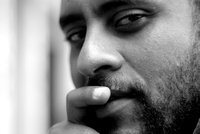Tadias Magazine
By Tadias Staff
Updated: Friday, September 16, 2011
New York (TADIAS) – Addis Ababa does not have a Red Light District per se, but the Sebategna area in Merkato comes close to it. Photographer Michael Tsegaye’s intimate portraits of prostitues from this neighborhood, entitled Working girls II, is currently showing at a highly-regarded international exhibition in Paris dedicated to non-Western photography. He is one of 46 contemporary photographers from 29 countries whose work is on display through November 11th, 2011 at the 3rd edition of the Photoquai Biennale exhibition of world images organized by the musée du Quai Branly.
“I wanted to share what I saw, but ultimately everyone will have their own response to it,” Michael Tsegaye, who was born and raised in Addis Ababa, said in a recent interview with Tadias Magazine. “A lot of the women, as well as the customers, come from many different parts of the country, since it’s close to the central bus stop. This creates an interesting social dynamic.”
And how did he gain the women’s confidence for such a close-up look at their lives? “I spent about two weeks with them, spending the day in the room where they live,” he said. “The first three days were very quiet, until they got used to me. We spent a lot of time talking, eating meals together, drinking tea and coffee.”
Below is our Q & A with photographer Michael Tsegaye:
—
TADIAS: What prompted you to focus on this issue?
Michael Tsegaye: I had taken photographs of prostitutes in Sodo a long time ago, but then wanted to continue the project. I decided to try it in Addis Ababa since it is a very sensitive issue.
TADIAS: What do you want people to take away from these images?
MT: Whatever they’d like. I wanted to share what I saw, but ultimately, everyone will have their own response to it.
TADIAS: You say on your website that as a photographer you don’t want to be “pigeonholed.” What do you mean by that?
MT: It’s common for people in the art world to first define you as an Ethiopian or an African artist, as opposed to just an artist. Once you are labeled in that way, you are then easily exotified. You are not given equal stature with other international artists – -the Europeans, Americans etc. Your work is not judged on its artistic merit, or the idea it represents, but rather which continent it comes from.
TADIAS: How did you get into photography?
MT: It was by accident. I used go to the Geothe Cultural Center to use the library, and one day I came across a photography workshop that was being led by a German photographer called Ralf Becker. I sat in on the class, and he thought I was a student. Later, I walked up to him to ask questions and we started a conversation. He asked me to join the class, and I did. We are still good friends to this day. He bought me my first camera, a Minolta analog.
TADIAS: What is good photography?
MT: There is a quote by a Frenchman called Jacques Leenhardt. It says: “Photography is best when it emulates poetry”, portraying “… not only the complex and problematic reality of the outside world, but also the way a person’s eye has seen it. It shows a person’s self-expression, a person becoming the poet we all have within us…” I think this is a very true statement.
TADIAS: Do you have a favorite photographer?
MT: I dont have a favorite photographer, but I have favorite painters, like Vermeer, Rembrandt, and Repin. I like Vermeer and Rembrandt because they make good use of light, while Repin’s composition is a great example of Russian painting.
TADIAS: We understand that you too started out studying painting but later developed an allergy to oil paint? Can you tell us more about that and how it has impacted your artistic expression?
MT: Over time, the hours I had spent in the studio breathing in fumes from the oil paints made me very sick, which forced me to give up painting. I then switched to photography as my main medium of expression. In terms of its effect on my overall artistic expression, as a whole, painting and photography are very different disciplines. With painting, I spent a lot of time in the studio. But photography forces you to interact with people, to explore the country and what is around you. From painting, I learned how to use light and composition in my photographs, so it has made learning photography much easier for me. I try to photograph with a painter’s eye.
TADIAS: Regarding the photos in your latest exhibition, is there a reason why you selected the Sebategna area in Merkato?
MT: Yes. Sebategna is an area heavily populated with commercial sex workers. Since there are so many, over time the area has formed its own subculture. In Sebategna, you will find a diverse range of prostitutes: from the very inexpensive, to the more costly. They are also diverse in age as well. A lot of the women, as well as the customers, come from many different parts of the country, since it’s close to the central bus stop. This creates an interesting social dynamic.
TADIAS: How did you gain the girls’ confidence?
MT: I spent about two weeks with them, spending the day in the room where they live. The first three days were very quiet, until they got used to me. We spent a lot of time talking, eating meals together, drinking tea and coffee.
TADIAS: Any parting words?
MT: I’d just like to thank Tadias Magazine and urge the Tadias audience to continue supporting Ethiopian arts.
TADIAS: Thank you and wishing you continued success.
MT: Thank you very much.
—
Learn more about Michael Tsegaye at: www.michaeltsegaye.com.
